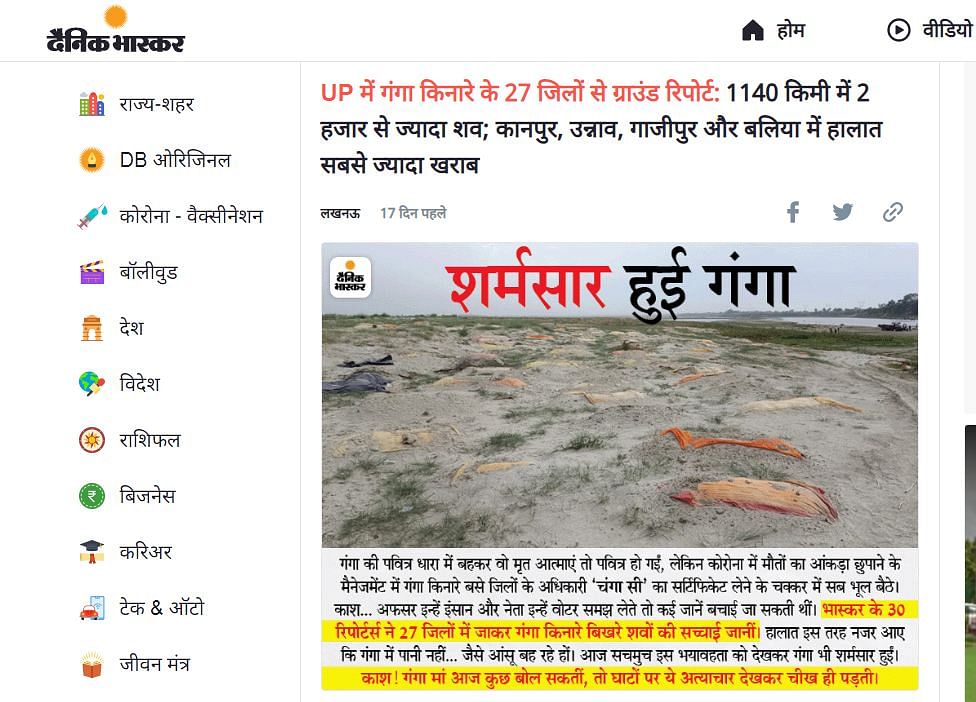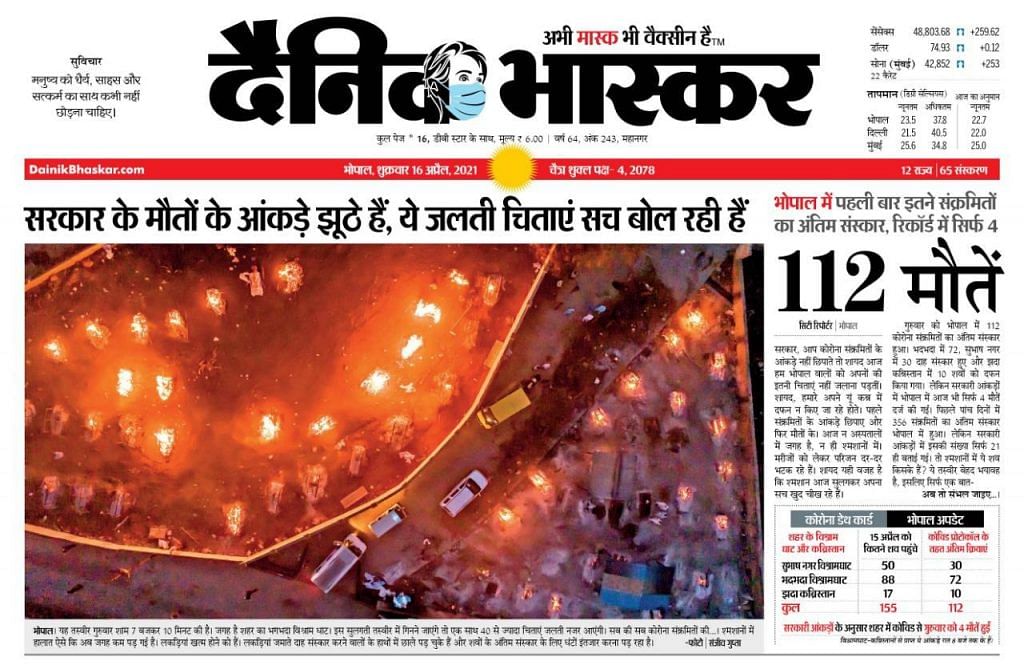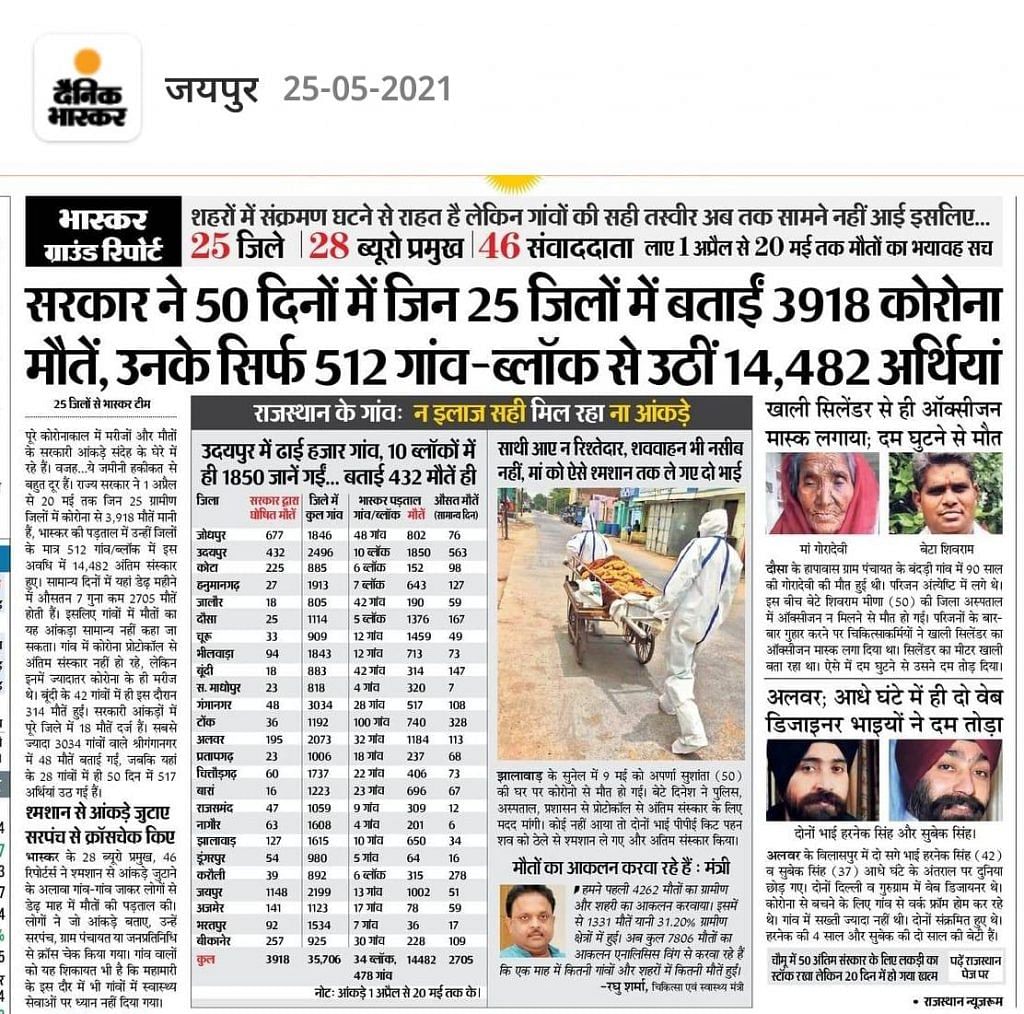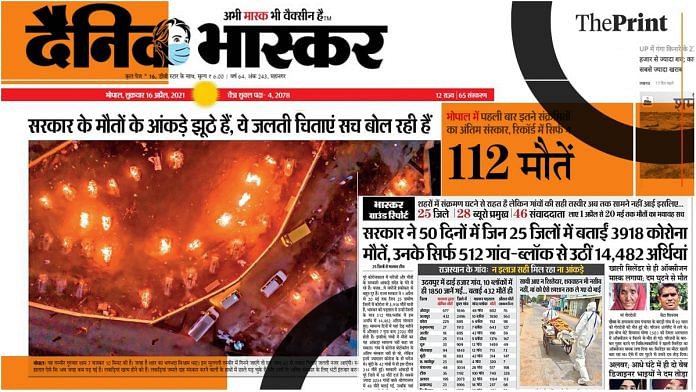New Delhi: Right in the middle of the second wave of Covid, on 14 May, Hindi daily Dainik Bhaskar carried a horrific report on its front page.
‘Sharmsaar hui Ganga’ or ‘Ganga is ashamed’, screamed the headline. The story highlighted unusual rows of corpses floating in the Ganga — roughly 2,000 over a 1,140-kilometre shoreline in Uttar Pradesh.
They were the unspoken dead of the pandemic, denied treatment when alive and dignity in death. They were loved ones dumped in the river as kin battled the virus, the state’s alternative narratives, and even wily traders who made wood prices unreachable for a simple cremation.
That story — put together from 27 UP districts — was to be the forebearer of the group’s relentless coverage of the pandemic.
The country’s largest circulated daily, with 65 editions, sent around 40 reporting teams to 12 most-affected states to ferret out facts from the ground.
Narratives merged with painstakingly-curated data from the ICUs, the morgues, the crematoria, the river and its bed — putting the group at the centre of some hard-hitting journalism, spewing follow-ups by the national media and observers abroad.
Within three days of that report, Bhaskar published another story titled ‘Ab bhi shavon se bhari ja rahi hai Ma Ganga ki god’ or ‘Mother Ganga’s lap continues to be burdened by dead bodies’.
The report highlighted an increase in bodies floating in the river as noticed from Prayagraj’s Shringverpur. Hinting at the state’s continuing apathy towards Covid victims, the story noted how the number of corpses sighted had increased from 8-10 a day to 60-70, and on some days over 100.
All editions of the newspaper maintained the rigour and focus in covering the pandemic — bringing the truth home, much to the chagrin of state governments.
Also on 14 May, the Gujarati arm Divya Bhaskar uncovered the fudging of numbers that pointed at massive undercounting of the Covid dead.
Reporters found that 1.23 lakh death certificates were issued between 1 March and 10 May — a significant rise from the figures during the same time last year — while Covid deaths released by the state were only 4,218.
A photograph published in the Bhopal edition on 16 April was a precursor of things to come. The aerial photo was of burning pyres in Bhopal’s Bhadbhada Vishram Ghat, and received massive global attention.
Roughly translated, it was headlined: ‘Government’s death figures are false, these burning bodies are telling the truth.’
In Rajasthan too, Dainik Bhaskar carried a deep-dive report in its Jaipur edition, refuting the state government’s figures.
On 25 May, the paper stated how 512 villages of the state reported 14,482 deaths in 50 days contrary to the government’s claims of 3,918 Covid deaths in 25 districts.

The publication deputed as many as 207 reporters across Madhya Pradesh, Rajasthan, Gujarat and Uttar Pradesh for its Covid coverage. Nationwide, it pushed to service nearly 80 per cent of its reporting strength to get the Covid story as it was really breaking on the ground.
“Volunteers were sought from reporters and they were given full assurance that all expenses would be taken care of by the company,” said a senior executive from the company, who refused to be named.
Asked about the safeguards proposed by the group to its reporters who were covering the pandemic on ground, another senior executive said the reporters have all been vaccinated.
“Also, whenever they go for ground coverage, they are fully equipped with the safety equipment like face mask, PPE kit, face shield and eye cover glasses. They follow all Covid protocols including social distancing.”
The executive added that the group also has a bereavement fund to provide financial support to deceased employees’ families — the salary is continued to be given to a family member for 12 months.

Also read: ‘Dead body could infect us, wood is expensive’ — tragic stories of Covid victims in Ganga
The editors behind the carpet-bombing reportage
The Uttar Pradesh edition had engaged nearly 90 per cent of its 98-member bureau as well as its strong network of stringers or retainers to tease out Covid stories, National Head (Satellite and UP) Om Gaur told ThePrint.
He said an input from Bihar’s Buxar on 12 May alerted them about the bodies floating in the Ganga.
“In the edit meeting that followed, we identified 27 districts in UP that lined the river. The very next day, we sent out 30 reporters plus photographers to all 27 districts to find out what was happening. The story was out by 14 May,” Gaur said.
He was also not taking any chances about the safety of his reporters, given they would be in the frontline covering a deadly virus. Only reporters who had got both shots of the vaccine or had recovered from Covid were selected for the job. “We provided them with PPE kits and all protective gear to ensure they were safe,” Gaur said.
He said the reportage also highlighted that villagers were not serious about the pandemic. The body count was pushed up more because of this and not just because of no treatment in villages and remote areas, Gaur said.
Reporters also noticed the alarming number of jhola chhap doctors (quacks) in Uttar Pradesh. “They are present everywhere — 30 per cent more than trained doctors,” Gaur said.
In Gujarat, Divya Bhaskar State Editor Devendra Bhatnagar noticed that death figures coming to light were different from the figures shared by the government.
He also noticed one day that out of their 16-page edition, eight were full of obituaries.
Bhatnagar said: “We analysed death certificates from 1 March to 10 May and found 1.75 lakh were issued.”
He added: “Keeping in mind that at times, death certificates can be issued more than once, we also sent reporters to crematoriums and burial grounds to cross-check the data. Additionally, we started checking the obituaries.”
That is how the paper arrived at the figure they published — 1.23 lakh certificates, but registered Covid deaths were only 4,218.
“It involved a lot of coordination. Our paper has 45 reporters in the state and almost 80 per cent of them were put on COVID coverage,” Bhatnagar said.
To ensure they didn’t miss anything, the edition formed a team of seven reporters and three photographers to constantly scour the streets for any unusual story.
Last month, Divya Bhaskar published the phone number of the state BJP chief on its front page, demanding to know how he had amassed 5,000 vials of remdesivir.
The Bhopal edition’s burning crematorium photograph on 16 April spoke truth to power.
The newspaper reported 356 last rites of those infected took place in five days when the government figure was 21.
Resident Editor, Bhopal, Upmita Vajpai told ThePrint: “A large chunk of our 14 reporters were tasked to cover the pandemic. We sent two reporters every day to crematoriums and burial grounds across the city to keep a tab on the number of deaths.”
They then started publishing what they saw, and exposed the government on its “undercounting”.
Vajpai added that reporters were sent to Covid hospitals and at times, when they could not even enter the Covid ward, they came back with shocking stories from outside the hospital.

The Rajasthan edition too doggedly pursued the dead.
State Editor Mukesh Mathur said 33 district bureau chiefs were told to send their reporters to villages to figure out how many deaths took place since 1 April.
“Initially, we had three teams of two reporters each tracking deaths in towns. Sporadic numbers came in. We then decided to coordinate in a bigger way,” Mathur said.
Reporters counted the dead in crematoria and burial grounds and cross-checked the number with village sarpanches.
Such meticulous work resulted in the 25 May report — 14,482 deaths in 512 villages in 50 days as against the government’s figure of 3,918 deaths in 25 districts.
Mathur said as many as 74 reporters worked on the story in 28 districts.
Editor, National News Room, Arun Chauhan said so much data-comparing was possible because bureaus inculcated the learnings from last year.
Bhaskar’s National News Room has different verticals that include reporting teams in major cities like Delhi, Mumbai, Lucknow and stringers in other cities to cover news reports of national interest. They also have a robust data analytics team.
“Our National Reporting Team (NRT) is based in Delhi. This team specifically works only on exclusives or breaking stories. This gives us the edge when it comes to breaking stories on a range of topics,” Chauhan said.
“Our data team too has converted numbers into stories, particularly trends. This was possible by consistently monitoring multiple data sets over a period of months.”
For any nationally-relevant story, Chauhan’s team seeks inputs from states or jumps on the field themselves, depending on the requirements.
Also read: Officials clueless, villagers blame ‘outsiders’ as Unnao finds over 100 bodies buried by Ganga
Bhaskar’s financial capability also made this possible, say senior journalists
Several senior journalists have recognised the scale and depth of Bhaskar’s Covid coverage. Veteran journalist N.K. Singh told ThePrint that the “quality” reportage has been unparalleled, compared to other Hindi and English newspapers.
“In the 42 years of my career, I am yet to come across such matured and unbiased coverage of an event by any other newspaper. Bhaskar has been consistently doing deep dive reports and bringing to the fore the real issues affecting public life,” said Singh, a former general secretary of the Broadcast Editors’ Association.
“Bhaskar’s reports not only activated the state apparatus, but also educated the common man. Whether it’s their reportage from Bihar on the concealment of deaths by the state or the counting of bodies floating ashore in UP or even the mismatch between death certificates and covid deaths in Gujarat, they have been doing quality journalism on Covid,” he said.
Stating that even English publications should learn from Bhaskar, Singh added: “The problem with English publications is that the stories told by them often do not reach the ground level as compared to Hindi publications.”
Senior journalist and author Mrinal Pande also said Bhaskar’s pointed Covid coverage has been “unparalleled”.
“Bhaskar has definitely been doing a good job and its coverage has been unparalleled. Through its scientific, simple and unbiased reports, Bhaskar has been able to reach the common man,” said Pande, former chief editor of Hindi daily Hindustan.
Pande said Bhaskar’s reach across the country and its financial capability also made this possible.
“There are certain smaller papers, such as Prabhat Khabar in Jharkhand or Nai Dunia in Indore, which also do a good job, but Bhaskar’s structure is big and it has a big penetration in Gujarat and Maharashtra, too. Perhaps, that is a reason why they have been able to send their reporters on such a large scale on the field,” she said.
“Smaller papers lack the financial capability to maintain such big teams and largely depend on freelancers for their reporting, which at times affect the quality of reports,” she added.
Also read: How earthen pots on peepal trees tell the real Covid death toll in UP’s Banda
Editorial line was to ‘focus on the ground’
Dainik Bhaskar was founded by Ramesh Chandra Agarwal in 1958 in Bhopal, Madhya Pradesh. Over the years, the group expanded to 12 states, particularly in the Hindi heartland. It is the largest read newspaper in the country. It currently has 65 editions.
According to the media ownership monitor report released by Reporters Without Borders and Dataleads, Danik Bhaskar is owned by D B Corporation Private Limited, a listed company.
Of the 69.82 per cent shares with the promoters, 15.07 per cent is directly held and split among Sudhir Agarwal and his brothers Girish Agarwal and Pawan Agarwal, the report says.
Dainik Bhaskar group ranks first as per the latest Indian Readership Survey data. Dainik Bhaskar is also the largest circulated daily, according to the Audit Bureau of Circulation report with a figure of 4.57 million.
Global association of newspaper publishers WAN IFRA ranks Dainik Bhaskar as the third largest-circulated newspaper internationally.
The group employs nearly 3,000 journalists across the country and also has a strong network of stringers.
After the second Covid wave hit India, the editorial leadership of Dainik Bhaskar felt at some point there wasn’t adequate coverage of the pandemic in rural India.
“We sent a team to check out the reality in Lalitpur at the UP-MP border. It gave us an idea of how things were in that corner. We expanded from there to the hinterland of other states,” said Chauhan.
He said the editorial line was to “focus on the ground”. Additionally, Chauhan said, it involved rigorous planning, collaboration and teamwork.
“The idea clearly wasn’t to do anything against anyone…(but) just to report what reporters would see themselves when they went to the ground. That is what we have been doing,” said a senior executive from the group.
Also read: ‘1, 2, 3, 4, 5…’ — UP fishermen count floating dead as poverty, rituals drive up river burials



